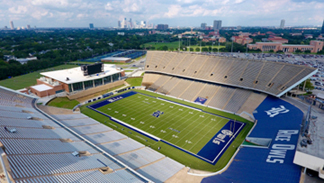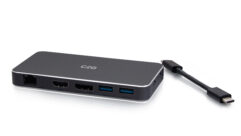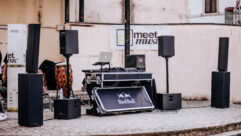
SVC Podcast – Show Notes – Show 165-1
In this edition of the SVC Podcast, SVC Contributing Editor Bennett Liles talks with Zach Richards of Big House Sound and design consultant John Miller of Technical Design Group. They discuss the design and installation of the new sound system for the Rice University football stadium and the challenges they faced with the project. The stadium’s acoustics, RF coordination and working in Houston’s summer heat were all problems to overcome with the sound system’s completion in time for the opening of the 2016 Rice Owls football season.
For Part 2
Links of interest:
- d&b 30D Power Amplifiers used in the main system
- QSC Q-Sys CORE 500i central processor
- d&b J8 WR Line Array Loudspeakers used on each side of the display
- d&b Vi8 WR Line Array Loudspeakers installed as side fills
Download Podcast Here:
https://s3.amazonaws.com/nb-svc/public/public/165-1_Rice_University_Soun…
This is the SVC Podcast from Sound & Video Contractor Magazine with Zach Richards of Big House Sound and John Miller of Technical Design Group. Show notes and equipment links for the podcast are on the web site of Sound & Video Contractor Magazine at svconline.com.
The recent installation of the huge video display at the Rice University football stadium needed an audio system to make it sound as impressive as it looked so they called in John Miller of Technical Design Group to draw it up with a plan. Then Big House Sound came in to install it and get everything up and running. Designer John Miller and installer Zach Richards are here to tell us about it. That’s up next on the SVC Podcast.
Zach and John, thanks for joining us on the SVC Podcast, Zach from Big House Sound and John from Technical Design Group and a huge sound system to accompany the giant new video display at Rice University’s football stadium in Houston. A few weeks back we were talking about their new video display and it became evident that this sound system was a big enough project to have a look at in itself. Zach, you can start off by telling us about Big House Sound.
Zach: Well, I appreciate it Bennett. Thanks for having us. And yeah, Big House Sound is a company here based out of Austin, Texas, but we do installation work all over central Texas and beyond. And we were fortunate enough to be a part of the Rice University audio system project which was designed by John Miller and the Technical Design Group. And yeah, it’s just been a fascinating project for us to be a part of. We specialize in audio systems for a wide variety of applications including athletic facilities and also theaters, music performance venues, a lot of houses of worship, restaurant, retail, hospitality. Kind of the whole nine yards. The stadium at Rice was certainly a pretty sizeable project for us. It was a challenge and we were glad to be a part of it, though. [Timestamp: 2:02]
And John, you had the conceptual part of this as the system designer. Was there anything especially difficult? I would guess that the huge scale of this place might have been a challenge in itself. What was it like on the design end of this?
John: The design side of this thing was relatively straightforward with the owner’s parameters for excellent sound throughout. The design flaw that we have in the facility is we have glass on three sides of that facility making primary and discrete reflections very prominent throughout the stadium if the sound system is not aligned properly. [Timestamp: 2:37]
All of this centers on the big end zone display and the sound wings that come off of that but was everything installed in there or were there other speakers put in around other places in the stadium?
John: The primary PA is installed in the left and right loudspeaker enclosure associated with the video scoreboard display. There are some minor fill-in loudspeakers below the display on a concourse level as well as some additional 70-volt loudspeakers installed by Big House in the Press Box area. [Timestamp: 3:09]
And Zach, I was thinking that crowd noise would be one of the big problems for this sound system. Was that the big thing on this or just the vast area that had to be covered?
Zach: Well, that’s certainly right. I mean I think the challenge and any application like this where you’re talking about first of all a significant distance to cover from the loudspeaker arrays is to make sure that we have the SPL that we need to overcome crowd noise, but also the intelligibility at the far end of the field because we have to remember the system is shooting from one end zone across the entire field to the listening areas that are on either side. So you know we’re talking about a significant distance and of course with the university stadium there’s a significant amount of seating that goes up and the bowl’s on either side. So yeah, absolutely being able to get that intelligibility and coherency throughout the listening area is a key part of this and John did a tremendous job, I think, on the design. And certainly we coordinated closely with them throughout the process. [Timestamp: 4:06]
And where do you have the amps and the control equipment located? Is that in the press box area?
Zach: It’s a combination of the two. Of course we want the amplifiers to be located as close to the loudspeaker arrays as possible and so the design called for the amplifier rack to be housed in the same building that the video display is mounted on top of it. It’s the new facility there for them at Rice. So the amplifiers are there and all of the control equipment, the mixing console and so on and so forth is in the control room that’s on the press booth level, if you will. And so we’re communicating via Qsys network. We’ve got actually Dante going into Qsys and then via fiber down to the amplifier rack. And then at that point we’re converting to AES, which is driving the amplifiers there on the broadcast facility. [Timestamp: 4:55]
And these games are all big television events. What happens when the broadcast trucks come in? Did this sound system include a big breakout panel somewhere for the broadcast trucks to connect to for the game coverage?
John: Yes. There is a broadcast pedestal on the northwest side of the stadium that all of the broadcast cabling terminates and then feeds into the production studio there in the new facility. [Timestamp: 5:19]
And I was wondering about this. How do you delineate between the mics? Are they all selected and run by the NCAA or some other ruling body or do they use your house sound system? How does that work?
John: As far as the referees themselves?
Yes, the referees.
John: The referee mics are specified by the design consultant or the owners – or referred to the owner for their preference, but there is a criteria as far as the type of microphone that is utilized by the referees for each conference for Division 1 college football. But the manufacturer is typically left up to what is preferred by the university. [Timestamp: 5:56]
Okay. And Zach, when you installed all of this how did you do the mic system receiving antennas? You’ve got to work at a great distance on the wireless mics and that can be critical on the distance between the antennas and how you get the signal to the receivers.
Yeah, well certainly that’s a great question. One of the biggest challenges here is that we knew ahead of time going into the project that the area where the stadium is and Rice University is has a lot of RF activity. And so we were hearing from the client that they’ve had issues in the past. We really wanted to make sure that we picked the right frequency band and really found a good spot, so we actually ran about four days frequency tests using Shure’s Axient system. Because, you know, we didn’t just want to take a snapshot of available frequencies. We wanted to know what the whole spectrum looked like over a four-day period. So I’m glad we did too because we certainly saw significant bands that were available or appeared to be available. At one point, for example, I think Friday afternoon or Friday everything looked very available on this one particular band but sure enough later on that evening when we were looking at our frequency analysis we saw a huge spike across that whole band. So really that was our biggest asset in setting up the wireless system was really knowing and understanding the RF environment around the university. And once we were able to identify clean, open bands, that of course where we put the wireless. And then we’re using an antenna system that’s mounted at the press booth that is a directional antenna system that’s outdoor rated active directional antenna that really lets us make sure that we’ve got the coverage that we need. But again I think that the primary thing there is just having open and available bandwidth where we’re not getting stepped on by other RF interference in the area. [Timestamp: 7:40]
And Zach, the design called for most of the acoustic power in this system to be right there in the display structure so when it came to the real grunt work on getting this stuff up there, what was involved in rigging the speaker arrays on the sides of that big display?
Zach: Certainly a challenge. I will say that we were using the d&b J-series line array boxes which we were very familiar with and are also extremely easy to rig. And so that part made it easier for us. One of the things that also helped us out is in the design process in coordination with John and also the engineering team that designed and fabricated the steel structure we were able to design kind of a multipoint grid system that let us suspend the d&b boxes off of that grid. That was extremely helpful because we could get the array in place but still be able to make minor adjustments to the angles both horizontally and vertically having that multipoint grid system in there. But I’m not going to lie. It was a huge challenge. The schedule worked out such that most of the array rigging was happening in July and August in Houston, Texas which is extremely hot and our team just did a fantastic job. Tim Kennard, our project manager and our whole crew out there in pretty much the hottest conditions possible getting those arrays hung and really impressed and happy with how everything went there. [Timestamp: 9:05]
And John, since you designed this thing and were the go-to guy on the concept end of it, have there been other stadium projects that you’ve found anything familiar on working with this one?
John: Well, point source system for any facility is common due to the financial benefits of a point source system in lieu of a distributed system. It’s just the cost factor for going with a distributed system that eliminates it from most consideration because of financial responsibility. Each facility is unique in its own way, but as far as on the design side the acoustical properties of the existing facility were a little more cumbersome than projects we’ve done in the past. [Timestamp: 9:44]
Zach, was there something you wanted to add to that?
Zach: Yeah, I was going to follow up on John, your comment from earlier. The acoustics are certainly a challenge and I think the results of that system really turned out nicely. We ended up doing a lot of EQ work and a lot of things to really minimize some of the acoustic challenges in there and I think that was fantastic. The other thing that I’d like to mention, and I believe this is true, this is the first stadium that has a d&b J-series system in it so it’s really great to be able to hear that system in this kind of setting. Of course we’re familiar with the boxes in more of a touring/performance context. But John, would you agree? I think the boxes sound really good in there and the end result was really nice.
John: I am extremely pleased with the performance of the sound reinforcement system in that facility.
And I know the fans are loving the big sound as well. It’s Zach Richards from Big House Sound and sound designer John Miller with Technical Design Group and the big new sound system at the Rice University football stadium in Houston. Thanks guys for getting with us on the SVC Podcast.
Zach: Well, Bennett, thank you so much for having us. We really appreciate it.
John: Thanks, Bennett.
Thanks to Zach Richards and John Miller for joining us on the podcast. Show notes and equipment links are on the website of Sound & Video Contractor Magazine at svconline.com. Next week Zach will be back with us to provide more details on the sound system installation at Rice University stadium. That’s on the next SVC Podcast.










